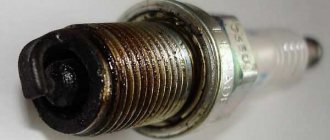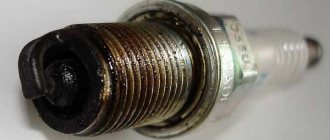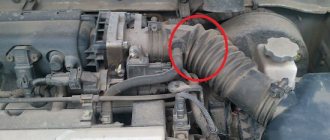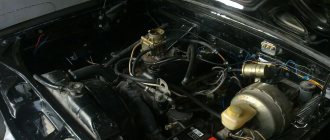What does the color of carbon deposits on spark plugs indicate?
In older cars, it was normal practice to bake out the spark plugs. What did it mean? The user unscrewed them and calcined them over a fire with a burner to burn off the resulting deposit of hydrocarbons. It was enough to hold it for a few minutes, and then let it cool and clean it mechanically, without disturbing the gap and integrity of the parts. This was normal, but how could such signs be normal for a modern car? The color of the spark plugs is actually of great importance and will tell an experienced driver about the presence of defects. Black soot of different shades may indicate to an experienced craftsman the following signs:
- poor quality of fuels and lubricants;
- poor fit of the rings to the cylinder walls;
- poor quality or wear of the spark plugs themselves.
A beginner will understand the harm and be able to distinguish the difference, but everyone will see that it is wet or dry. What this means is a separate question, because there can be several reasons. White soot also does not bring anything good and has its own reasons.
Types of soot
Yes, indeed, black carbon deposits on spark plugs mean a lot. This is especially true for domestic cars VAZ 2109, 2114 and other brands. To deal with the consequences, it is necessary to study all the states of the spark plugs in which they are in the engine. So, a candle has the following symptoms:
- Completely dry and no traces of soot - this condition indicates the absence of any problems with the internal combustion engine or they were just recently screwed in and have not expired to determine the condition.
- Wet - a problem with the carburetor, which pours an excessive amount of fuel into the cylinder.
- Dry, friable - long-term operation on an enriched fuel mixture, incomplete removal of exhaust gases from the cylinders.
- Oily black – the color of the soot has its own problem. But it is important to consider not only color, but also structure. Oil should not penetrate the cylinders at all.
Each state of the candle speaks volumes. This applies to absolutely all cars, it’s just more pronounced in older ones due to their service life. Old spark plugs must be replaced promptly.
Repair recommendations
Regarding repairs, we will consider each case individually, since individual faults and types of soot indicate the need for different types of repair work .
Oily black soot
The appearance of oil deposits indicates the penetration of oil into the combustion chamber. Accordingly, it is necessary to thoroughly study the condition of all components that could cause such a defect, and, if necessary, replace them. These components are :
Guide bushing wear
Wear of valve stem seals
The problem relates strictly to the wear of components of the cylinder-piston system. Accordingly, they must be replaced.
Dry black carbon
Regarding the second type, there are several more reasons than in the case of oil deposits . And it is impossible to clearly understand which one is causing the soot without checking each one.
- The first, easiest to check is a faulty spark plug, or lack of energy in it, the solution to the problem is to replace the spark plug.
Changing the spark plug
We measure the compression in each cylinder
Adjusting the fuel pressure
Cleaning the air filter
Checking for errors
Causes of black carbon deposits on spark plugs
Does your car have one black spark plug or are they covered in soot and oil all over? Don't hesitate because there is a growing problem in your car's engine that could cause more serious damage. The color condition of this spare part speaks volumes, so it is recommended to contact experienced service professionals. Unfortunately, there are many reasons why soot appears on candles. Let's look at them in more detail, indicating more precise signs of the defect.
The ideal condition of the engine is a dry spark plug, if, of course, the part was installed a long time ago and the car worked on it a fair amount. There should be dryness on all cylinders, which can also be one of the diagnostic methods. Sometimes, before selling a car, former owners install new spark plugs to cover up problems. But even in a short time, some traces will definitely appear on them.
If the candle turns black quickly, literally within a few trips, then you should sound the alarm. The engine develops a problem that may become critical. Carbon deposits can appear due to a breakdown in the power unit, in particular, wear of the piston pair, incorrect ignition angle setting, incorrect operation of the fuel system, and much more. It is important not to get confused, because a spark plug can turn black for completely different reasons, and the wrong direction during repairs can cause additional problems. Black carbon deposits need to be treated correctly. Considering engine failures exclusively, the reasons may be as follows:
- valve burnout;
- mismatch in heat rating;
- incorrect ignition angle;
- highly enriched fuel mixture;
- clogged air filter;
- increased pressure in the fuel rail;
- low compression;
- insufficient self-cleaning;
- inconsistency of fuel quality;
- defects in the spark plug itself.
Black spark plugs. Cause: valve burnout
Each engine cylinder is equipped with intake and exhaust valves. During operation, a huge temperature is created inside, comparable to the melting point of the metal. This leads to related problems. For example, a valve burnout occurs. Spark plugs become covered with a black coating due to burnout of the valves, but why does it occur, strictly speaking? To fix the problem, you need to dig deeper and find out why the spark plug on the injector turned black and why the valve burned out? In such a situation, a diagnosis is carried out, and an experienced technician determines one of the following root causes:
- valves are pinched;
- the guide bushing is worn;
- valve stem is damaged.
Also, sooty spark plugs may be due to running on a very lean mixture. This defect especially manifests itself on machines on which gas-cylinder equipment is installed. The specific cause is determined through detailed disassembly and diagnostics.
Spark plugs - black soot due to mismatch in heat rating
A candle is not an ideal product that has the same characteristics. Manufacturers make them differently, and one of the characteristics is the heat rating. It reflects the period of time during which the spark plug completely switches to glow ignition, that is, a spark is practically no longer needed to ignite the fuel. It is ignited by heated candles. Accordingly, the longer this time interval, the longer you need to act on it to heat it red-hot. If your car is equipped with spark plugs with a low heat rating, they will warm up quickly and the operating mode of the internal combustion engine will be disrupted. When will the driver notice this problem? Not right away, because at low power the motor works fine. As speed increases and temperature rises, power drops and fuel is wasted.
Why do spark plugs turn black when ignition is late?
To determine late ignition as the main cause of blackening of the spark plug, it is necessary to observe them. A black coating will gradually form on them and intensify. Late ignition will disrupt the operation of the internal combustion engine. This will not only be visible on the candles, but will also be felt by ear. The engine begins to vibrate slightly as the gases inside the cylinder do not have time to escape and hit the exhaust valve. The ignition must be adjusted so that the fuel has time to ignite, burn to release the required energy and be pushed out through the valve. For this, a hall sensor is used and a complex control unit is installed. The injection and ignition systems are synchronized to ensure maximum efficiency.
Rich air/fuel mixture
The engine of a modern car has very fine tuning. All processes must be perfectly tuned in it so that maximum power is provided to the shaft throughout the entire operating cycle. This also applies to the degree of fuel enrichment with oxygen. The optimal ratio of oxygen to fuel is 15:1, that is, 15 volumes of air are used and only 1 volume of gasoline. If this concentration changes, the amount of fuel increases, then the mixture becomes rich. When it burns, more soot and soot are formed in the cylinder, which is why the spark plugs are black. The increased amount of combustion products does not have time to leave the volume and does not burn out completely, settling on the walls of the parts.
Clogged air filter
For normal operation of an internal combustion engine, a lot of oxygen is required. As stated earlier, only 1/15th of the fuel volume is needed to obtain the optimal ratio. This balance can be upset in two ways: give more fuel or let less air into the engine. The second is more likely, since the air filter becomes the only obstacle to the air flow. Black soot is formed as a result of disruption of the fuel combustion cycle, and is formed from unburned products in the form of soot.
Problems with the ignition system
The internal combustion engine should be considered like a Swiss watch. All processes must be perfectly tuned to ensure maximum power and endurance under load. The basic or primary setting of the ignition time of the fuel mixture in the cylinders is performed by the car manufacturer. During operation, this happens automatically, due to a system of sensors and algorithms debugged by specialists. For example, ignition that is too late may well cause the formation of a black deposit, since all the fuel does not have time to burn and flies out alive into the exhaust manifold.
Excessive pressure in the fuel rail
The fuel rail is a pressure regulator for the flow of flammable liquid, which is then directed to the injectors for injection. The efficiency of the internal combustion engine and the condition of its parts directly depend on it. The RDP supplies fuel to the atomizers in a dosed manner, but the device settings can be changed. This is done to ensure maximum power of the power unit. The control limit is small, since the slightest changes already lead to a significant change in the operating cycle. Simultaneously with the formation of carbon deposits on the spark plugs, unstable engine operation also occurs, increases fuel consumption, slow response to the gas pedal, and lack of acceleration.
There is black soot on the spark plugs due to poor self-cleaning.
To ensure that the motor runs for a long time and smoothly, the manufacturer came up with a special mode - self-cleaning. This is a procedure in which the temperature in the cylinders rises to high values. The candles heat up to 400 degrees. All hydrocarbon deposits formed on them spontaneously burn. For various reasons, this operating mode may be disrupted, which leads to insufficient cleaning of the spark plugs. Almost any car can be switched to this mode. To do this, it is enough to accelerate to maximum speed, but it is safer to give the gas in a lower gear so that the speed remains at least 5 thousand.
Why is the spark plug black when compression is lost?
Another cause of black deposits on spark plugs is low or insufficient compression. This defect manifests itself in several signs:
- Reduced power because the cylinder is not sealed and the pressure is released into the cavity rather than used to rotate the piston.
- Oil deposits and black soot form on the candles, because when the oil burns, a lot of products are released, which settle on the walls.
- The quality of the exhaust deteriorates and the car begins to “smoke” in the literal sense of the word.
Why is the spark plug black due to unsuitable gasoline?
Gasoline and gasoline are different. This type of fuel varies depending on the initial quality of the oil. But as a result of sublimation, it must fully comply with the standards. Therefore, there are two main reasons for the decrease in its quality: violation of production technology and dilution after sublimation. The higher the octane number, the better and at a higher temperature the gasoline burns. When it is diluted, the efficiency decreases, but the amount of combustion products that remain on the walls in the form of soot increases.
Why is there a black candle on the walk-behind tractor?
There is a technique in which the spark plugs are black and this is considered a normal condition. Of course, it’s not entirely correct, but it solves a lot of other problems. Sacrificing the service life of the piston and spark plugs, manufacturers simplified the design. As you know, a small engine does not have a cooling and lubrication system. It is supplied to the cylinder along with fuel, which makes the units more mobile and compact. In order for walk-behind tractors to work properly, you need to periodically clean the spark plugs from deposits.
Spark plug defects
Only problems in the internal combustion engine should not be considered as the cause of blackening of spark plugs. This phenomenon can also occur due to the presence of a defect in the candles themselves. It is a device consisting of several elements. If production technology is not followed or worn-out ones are used, various defects may appear.
Troit engine | Twokarburators.ru
— The engine “troubles” - twitches at idle.
Popping noises are heard from the muffler; — When starting the engine, on “choke”, the speed is stable, without “chuck” on a warm engine, the idle speed is unstable until it stops.
Often, unstable engine idle speed is accompanied by increased fuel consumption and loss of power and throttle response.
Causes of "triple" - unstable idling of the engine of VAZ 2108, 2109, 21099
Let's look at the reasons for unstable engine idling (engine troits) on VAZ 2108, 21081, 21083, 2109, 21091, 21093, 21099 cars with carburetors 2108, 21081, 21083. Here is a list of reasons for the vehicle systems, a more detailed analysis of each of the reasons is given in individual articles available via links in the article.
The carburetor is faulty or not adjusted
— The idle speed adjustment with the “quantity” and “quality” screws of the fuel mixture is broken
Adjust the idle speed using these screws. By rotating the screws clockwise we increase the fuel supply to the cylinders, counterclockwise we decrease it. Normal idle speed for engines 2108, 21081, 21083 of VAZ 2108, 2109, 21099 cars is 750-850 rpm.
“Adjusting the idle speed of the carburetor engine of VAZ 2108, 2109, 21099”
— The carburetor solenoid valve is faulty
We check its serviceability for a “click”. We remove the wire tip from the valve terminal and put it on again; a “click” should be heard. This shut-off needle is pulled into the valve body and opens the hole for fuel to pass through. There is no click - the valve is faulty, or there is no current flowing through the wire.
“Carburetor solenoid valve 2108, 21081, 21083 Solex. Inspection and repair"
— Foreign air is “sucked” into the carburetor, excessively leaning the fuel mixture
The culprits may be - a hose from the vacuum brake booster to the intake manifold (1), rubber sealing rings on the “quality” screw (8) and the solenoid valve (4), a slipped or burst tube to the housing of the vacuum ignition timing regulator on the distributor (2), leaky housing or damaged diaphragm of the vacuum regulator housing (6), deformation of the carburetor seating surface (5), or wear of its gaskets, crankcase ventilation tube (3), gasket under the intake manifold (7).
“Causes and elimination of foreign air leaking into the carburetor 2108, 21081, 21083 Solex”
— The channels and jets of the carburetor idle system are clogged
“Cleaning the idle system of the carburetor 2108, 21081, 21083 Solex”
— Low fuel level in the carburetor float chamber
“Adjusting the fuel level in the float chamber of carburetor 2108, 21081, 21083”
— The air filter element is clogged
The degree of contamination should be quite high. Replace it with a new one.
The power system before entering the carburetor is faulty
— Fuel pump is faulty
“Fuel pump malfunctions in VAZ cars.”
— Filters in the power system are clogged
This is a filter on the fuel intake in the gas tank, a fine fuel filter and a mesh filter in the carburetor.
— Damaged elements of the power system
“Possible malfunctions of the power supply system of VAZ 2108, 2109, 21099”
Ignition system is faulty
— Spark plugs are faulty
“Diagnostics of spark plug faults”
— The distributor (cover, slider) is faulty
“Malfunctions of the ignition distributor (distributor) of VAZ 2108, 2109, 21099 cars.”
— High-voltage wires are faulty
“Checking high-voltage wires on a VAZ 2108, 2109, 21099”
— The ignition timing is not set correctly
“Setting the ignition timing on VAZ 2108, 21081, 21083 engines”
The power supply system is faulty
— Short circuit in the wiring
“Short circuit, how to determine where”
“Cliff, how to find it.”
Engine faulty
— Thermal clearances in the valve mechanism are broken
“Checking thermal valve clearances on VAZ 2108, 21081, 21083 engines”
— Marks in the timing system are shifted
“Replacing the timing belt on engines 2108, 21081, 21083 of VAZ 2108, 2109, 21099”
— Wear of the piston group (breakage or sticking of rings, wear of cylinders)
"Diagnostics of CPG engines 2108, 21081, 21083 of VAZ 2108, 2109, 21099"
— Burnout of valves
“Valve burnout, signs, causes” Notes and additions
— Before you begin to identify the causes of engine “triple” at idle, it is necessary to conduct a visual inspection of its engine compartment. A loose wire, a chip not fully inserted, a kinked hose, etc. will not allow the engine to work normally, and will take away the time and effort of the car owner spent on troubleshooting.
More articles on VAZ car engines
— The engine smokes (black smoke from the muffler)
- Shoots at the silencer
— Idle speed floats
— Glow ignition
— The emergency oil pressure lamp is on
What to do if a black plaque appears
The presence of black deposits on the spark plugs is not a normal condition of the part. It is necessarily associated with some problem in the internal combustion engine, fuel system or ignition. It is necessary to respond quickly to prevent the problem from becoming more serious. The first step is to find out why the candles turn black and eliminate the root cause. If the spare part is still normal, then clean it from carbon deposits. You can use special tools or use the old-fashioned proven method - calcination with a burner.
conclusions
Analysis of this problem and the experience of motorists suggest that visual diagnosis of spark plugs covered with soot is an excellent method not to miss the onset of problems with the car’s fuel system. You need to not be lazy and inspect these parts from time to time. In addition, do not forget that protective gear has its own service life, and when plaque appears, this is the first thing to check. If necessary, the spark plugs must be replaced and only then proceed with initial engine diagnostics.
How to remove black carbon deposits from ignition elements
If black deposits have formed on the spark plugs and in the cylinder, it is not so easy to remove. Still, there are several ways: chemical and mechanical. Both have their pros and cons. Let's take a closer look at each.
Mechanical cleaning method
This method consists of washing the oil, if any, in gasoline. Then the candle is dried and all carbon deposits are removed using sandpaper. It is important to monitor the size of the gap between the electrodes so as not to break it. The efficiency of ignition of the fuel mixture will depend on this. You should be careful, as you can break off the central electrode.
Chemical cleaning method
This method of removing black deposits from spark plugs involves using chemicals. It is highly not recommended to add additives to the internal combustion engine or fuel, even if sellers advise it. There will be more problems from them later. You need to unscrew the spark plugs and wash them in gasoline. Then take the ammonium acetate solution and heat it to 90 degrees along with the candles. For the reaction to react, it is recommended to keep them in the solution for at least 30 minutes. At the end of the procedure, you need to dry and wipe the candles dry. All the carbon deposits will be removed as if by hand.
Which color is not dangerous?
The performance of a gasoline engine directly depends on the condition of the spark plug electrodes. Their surface should be painted in a dirty brown shade, without traces of oil and soot elements.
If the surface of the spark plug is changed, it is recommended to carry out unscheduled technical diagnostics to detect the cause of such problems. Various parts of a gasoline engine can provoke such changes.
There are several color options that cover spark electrodes. These include:
- Grey;
- White;
- Terracotta;
- Red;
- Black.
The top of the spark plug may be covered with various deposits. Most often it is subject to oil deposits or a thick layer of soot. Such changes indicate serious problems with the engine.











